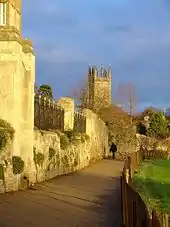Dead Man's Walk, Oxford
Dead Man's Walk (or Deadman's Walk[1]) is a footpath running east–west in central Oxford, England, situated immediately to the south of Merton College and just outside the old city wall, with Corpus Christi College at the western end.[2][3] To the north, Grove Walk connects with Merton Street through a gateway. Immediately to the south is Merton Field[4] with Merton Walk connecting to the wide tree-lined Broad Walk, which runs parallel with Dead Man's Walk. Beyond that is Christ Church Meadow.

History
The walkway itself appears to be the route of medieval Jewish funeral processions.[1][3] A procession would begin at the synagogue (near to where Tom Tower now stands) and proceed towards the Jewish burial ground (now the site of the University of Oxford Botanic Garden).[5]
Historical markers
Near to the eastern end of the walkway is a plaque marking the first hot air balloon ascent in Britain, made by James Sadler (1753–1828).[6] He ascended from Merton Field on 4 October 1784, landing nearby in Woodeaton.
There is a stone slab in the University of Oxford Botanical Garden with a history of the origin of the footpath. [7] It reads:
Beneath this garden lies a medieval cemetery.
Around 1190 the Jews of Oxford purchased a water meadow outside the city walls to establish a burial ground. In 1231 that land, now occupied by Magdalen College, was appropriated by the Hospital of St John, and a small section of wasteland, where this memorial lies, was given to the Jews for a new cemetery.
An ancient footpath linked this cemetery with the medieval Jewish quarter along Great Jewry Street, now St Aldates. For over 800 years this path has been called 'Deadman's Walk,' a name that bears silent witness to a community that contributed to the growth of this City and early University throughout the 12th and 13th centuries.
In 1290 all the Jews were expelled from England by King Edward I. They were not permitted to return for over 350 years.
May their memory be blessed
יהא זכרונם לברכה
Local legend
The walkway is the site of what has been described as one of the most well-known Civil War hauntings.[8] The ghost of Francis Windebank, a Colonel executed by firing squad in 1645 against the length of town wall that borders Merton College, has been reportedly sighted here. The ghost is allegedly only seen from the knees up, due to the raising of the ground level.[9] It has been suggested that reports of a haunting are to be expected here given the evocative name.[10] However, it has been a long time since any new reported sightings have been made.[11]
References
- Hibbert, Christopher, ed. (1988). "Deadman's Walk". The Encyclopaedia of Oxford. Macmillan. p. 117. ISBN 0-333-39917-X.
- Horan, David (2002). Oxford: A Cultural and Literary Companion (3rd ed.). Oxford: Signal Books. p. 29. ISBN 1-902669-05-3.
- Morris, Jan. Oxford (3rd ed.). Oxford: Oxford University Press. p. 234. ISBN 0-19-282065-6.
- Rhodes, John (1988). "Merton College from Merton Field, 30 April 1908". Oxford: The University in Old Photographs. Alan Sutton Publishing. p. 42. ISBN 0-86299-461-6.
- Symonds, Ann Spokes; Morgan, Nigel (2010). "Deadmans Walk". The Origins of Oxford Street Names. Witney, Oxfordshire: Robert Boyd Publications. p. 99. ISBN 978-1-899536-99-3.
- "Inscriptions: James Sadler's balloon flight". Oxford History. UK. Retrieved 27 May 2014.
- Stone slab in University of Oxford Botanical Garden, The slab was laid into the ground in July 2012.
- Walters, Rob (2010). "Dutiful Ghosts of the Civil War". Haunted Oxford. Stroud, Gloucestershire: The History Press. pp. 76–80. ISBN 978-0-7524-3925-9.
- Puttick, Betty (2003). Oxfordshire: Stories of the Supernatural. Newbury, Berkshire: Countryside Books. p. 28. ISBN 978-1-8530-6811-9.
- Andrews, Ross (2010). "Other Outdoor Oxford Venue". Paranormal Oxford. Chalford, Gloucestershire: Amberley. pp. 73–75. ISBN 978-1-4456-0002-4.
- Yurdan, Marilyn (2002). Unexplained Oxford and Oxfordshire. Dunstable, Bedfordshire: The Book Castle. p. 5. ISBN 978-1-9037-4721-6.